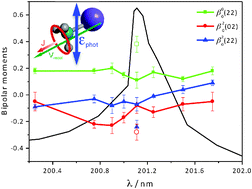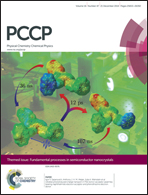Imaging the stereodynamics of methyl iodide photodissociation in the second absorption band: fragment polarization and the interplay between direct and predissociation
Abstract
The stereochemistry of methyl iodide photodissociation in the onset of the second absorption B-band has been studied using slice imaging of the CH3(ν = 0) and I*(2P1/2) photoproducts. The stereodynamical data have been crucial to disentangle the photochemistry of methyl iodide in terms of the competition between direct dissociation and electronic predissociation. The origin of the B-band has been established with high accuracy at 201.11 ± 0.12 nm and a depolarization factor due to parent molecule rotation during predissociation has been found to be 0.29 ± 0.06. Analysis of the semiclassical Dixon's bipolar moments extracted from the CH3(ν = 0) sliced images indicates that direct excitation to the A-band 3A1 repulsive state in the vicinity of the origin of the B-band is remarkably enhanced by vibrational coupling between the electronic states involved at the conical intersection through in-plane vibrational motion of the molecule.


 Please wait while we load your content...
Please wait while we load your content...